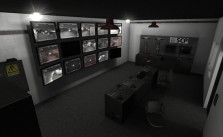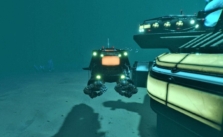Surviving the Abyss: Tips to Survive the Deep Unknown
Here’s a fun fact: did you know that we know more about space than we do about the deepest parts of the ocean? It’s true, there are parts of our very own planet that have barely been explored due to danger or lacking the right equipment to probe those inky depths.
In the new game from Paradox Arc and Rocket Flair Studios, the primary goal is to change that fact. It’s called Surviving the Abyss, and it will have you managing a research colony built on the ocean floor. Along with the regular day-to-day of managing scientists in their research endeavors, there are also dark, unknowable threats to contend with. Can you survive the abyss?
Well, with our help, you definitely can. We have a few tips for you that will help your colony thrive in the face of ancient entities, and as long as you heed our advice, your colony won’t have any problems! Hopefully…
Working Environments
First and foremost, Surviving the Abyss is a game about exploration. You’ll be navigating those dark waters to see what’s out there, and boy is there quite a bit to discover. Creatures, resources, structures of unknown origin, and more all await you. As you discover more of these things, you’ll also learn more about the world around you.
In your explorations, you will come across different biomes and environments. Each one will have its own look, resources, points of interest, and wildlife, so it is important to make notes of what can be found where. You’ll need that information at some point down the road.
The first environment is the Seagrass Dunes biome. The primary research facility is located there, and it has a good balance of basic resources you’ll need to get your base going. That means you’ll find standard building resources, coal, and concrete here in decent supply. There is also quite a bit of wildlife you can use in your cloning experiments.
As you outgrow the Seagrass Dunes, you’ll want to expand and check out other biomes. You can find the Coral Reefs, Kelp Forest, Dark Glows, Basalt Columns, and even an Active Volcano along the ocean floor. You’ll want to check out the Coral Reefs when you’re looking for more wildlife, the Kelp Forest for its advanced resources you can use for upgrades, and the Active Volcano when you need fuel. However, it is important to note that the Active Volcano doesn’t have any resources outside of fuel.
As you explore the ocean, you’ll find Points of Interest (POIs). These might be caves, sunken ships, and a number of other things. A POI will show up on your sonar, enabling you to send an expedition submarine to scope it out. If that expedition is a success, you’ll be able to collect resources and materials from that POI.
Managing Your Resources
In Surviving the Abyss, successful management of your resources will be the key to your success. You need to know where to get what you need, how to collect it, and then how to allocate it properly. There are three types of resources in Surviving the Abyss: building materials, fuel, and food.
You’ll need building materials to construct buildings. This includes things like concrete, quarts, iron, steel, aluminum, and copper. Fuel is used to power your base, and includes coal and oil. There is also low-quality and high-quality food you’ll need for your crew.
There are resources all over the map, but they won’t always be in good supply. You can rely on the starter biome for a little while, but you’ll need to branch out for other resources if you hope to make progress. When you find a biome that’s rich in a specific resource, it would be wise to set up a base there so you can harvest it.
As far as resources go, there are two types of deposits: small and large. Small deposits are easy to find and have a small amount of resources that can be obtained with mining relays and subs, but they don’t last very long. Large deposits, also called extraction points, are harder to find but have much greater amounts of a given resource. To harvest these, you’ll need to construct extractors directly on the deposit. Extractors work much slower than mining subs, but their output is much more stable and reliable.
While you’re hunting down resources, just remember that some are rarer than others. For example, you’ll need steel to construct most buildings, but there is a limited number of steel deposits on the map, and there are no steel extraction points. You’ll need to be careful and get creative with how you use steel, and we recommend building an alloy furnace building to process iron into steel for extra of the resource.
If you keep these tips in mind, you shouldn’t have an issue with resources in Surviving the Abyss. Keep an eye on what you have, be mindful of how much you’re using, and always be on the lookout for new ways to get what you need.
Seeing Double
Cloning is the primary type of experiment you’ll be conducting in Surviving the Abyss, and they’re kind of a tricky process. You’ll need the right approach, the right resources, and a skilled, diverse crew to pull these off successfully. In order to begin cloning, you’ll need genetic samples gathered from rare sea life. Scour the habitats spread around the map for those. Gather up those samples, and then take them to the Cloning Lab for sequencing. A Cloning Lab can be built on a habitat that has been converted into a Genetic Material source.
In the Cloning Lab, you can combine the samples you collected to create a new genome, which is what is used to determine the properties of the new clones. As an example, using samples with high Potency and a low Mutation rate will result in a clone with a higher chance of survival and a longer lifespan.
You’ll then want to use your newly created genome in a Cloning Vat to produce the actual clones. This takes time and resources, but once your clones are ready you can send them to the surface to be trained and assigned.
Cloning doesn’t come without risks. They might not be able to survive the process, they might come out with defects, or issues such as a high Mutation rate might cause them to have shorter lifespans and be less useful overall. Cloning is a powerful tool, but it requires you to plan carefully and manage your resources responsibly in order to be successful.











